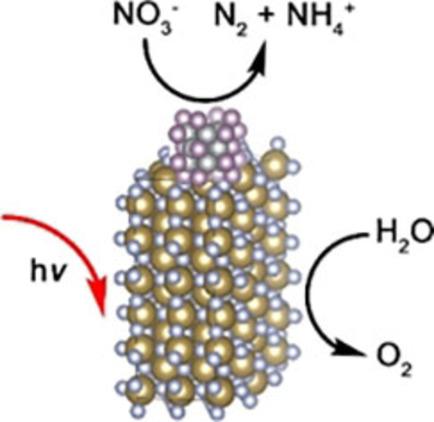当前位置:
X-MOL 学术
›
ChemNanoMat
›
论文详情
Our official English website, www.x-mol.net, welcomes your
feedback! (Note: you will need to create a separate account there.)
Ni2P‐Modified Ta3N5 and TaON for Photocatalytic Nitrate Reduction
ChemNanoMat ( IF 2.6 ) Pub Date : 2020-05-19 , DOI: 10.1002/cnma.202000174 Lin Wei 1 , Marquix A. S. Adamson 1 , Javier Vela 1, 2
ChemNanoMat ( IF 2.6 ) Pub Date : 2020-05-19 , DOI: 10.1002/cnma.202000174 Lin Wei 1 , Marquix A. S. Adamson 1 , Javier Vela 1, 2
Affiliation

|
Self‐sustaining photocatalytic NO3− reduction systems could become ideal NO3− removal methods. Developing an efficient, highly active photocatalyst is the key to the photocatalytic reduction of NO3−. In this work, we present the synthesis of Ni2P‐modified Ta3N5 (Ni2P/Ta3N5), TaON (Ni2P/TaON), and TiO2 (Ni2P/TiO2). Starting with a 2 mM (28 g/mL NO3−−N) aqueous solution of NO3−, as made Ni2P/Ta3N5 and Ni2P/TaON display as high as 79% and 61% NO3− conversion under 419 nm light within 12 h, which correspond to reaction rates per gram of 196 μmol g−1 h−1 and 153 μmol g−1 h−1, respectively, and apparent quantum yields of 3–4%. Compared to 24% NO3− conversion in Ni2P/TiO2, Ni2P/Ta3N5 and Ni2P/TaON exhibit higher activities due to the visible light active semiconductor (SC) substrates Ta3N5 and TaON. We also discuss two possible electron migration pathways in Ni2P/semiconductor heterostructures. Our experimental results suggest one dominant electron migration pathway in these materials, namely: Photo‐generated electrons migrate from the semiconductor to co‐catalyst Ni2P, and upshift its Fermi level. The higher Fermi level provides greater driving force and allows NO3− reduction to occur on the Ni2P surface.
中文翻译:

Ni2P改性的Ta3N5和TaON用于光催化硝酸盐还原
自我维持的光催化NO 3 -还原系统可能成为理想的NO 3 -去除方法。开发有效的,高活性的光催化剂的关键是光催化还原NO的3 - 。在这项工作中,我们介绍了Ni 2 P改性的Ta 3 N 5(Ni 2 P / Ta 3 N 5),TaON(Ni 2 P / TaON)和TiO 2(Ni 2 P / TiO 2)的合成。用2mM的(28微克/毫升无起始3 - NO的水溶液-N)3 - ,如由Ni2 P /钽3 Ñ 5和Ni 2 P / TAON显示高达79%和61%的NO 3 -下419纳米的光转换12小时,其内对应于每克196的反应速率微摩尔克-1 ħ -1和153μmolg -1 h -1,表观量子产率为3-4%。相比24%的NO 3 -转化以Ni 2的TiO P / 2,镍2 P /钽3 Ñ 5和Ni 2 P / TAON由于可见光活性半导体(SC)表现出更高的活性基片的Ta 3N 5和TaON。我们还讨论了Ni 2 P /半导体异质结构中的两种可能的电子迁移途径。我们的实验结果表明,这些材料中有一个主要的电子迁移途径,即:光生电子从半导体迁移到助催化剂Ni 2 P,并上调其费米能级。较高的费米能级提供更大的驱动力,并允许NO 3 -在Ni上发生还原2 P表面。
更新日期:2020-05-19
中文翻译:

Ni2P改性的Ta3N5和TaON用于光催化硝酸盐还原
自我维持的光催化NO 3 -还原系统可能成为理想的NO 3 -去除方法。开发有效的,高活性的光催化剂的关键是光催化还原NO的3 - 。在这项工作中,我们介绍了Ni 2 P改性的Ta 3 N 5(Ni 2 P / Ta 3 N 5),TaON(Ni 2 P / TaON)和TiO 2(Ni 2 P / TiO 2)的合成。用2mM的(28微克/毫升无起始3 - NO的水溶液-N)3 - ,如由Ni2 P /钽3 Ñ 5和Ni 2 P / TAON显示高达79%和61%的NO 3 -下419纳米的光转换12小时,其内对应于每克196的反应速率微摩尔克-1 ħ -1和153μmolg -1 h -1,表观量子产率为3-4%。相比24%的NO 3 -转化以Ni 2的TiO P / 2,镍2 P /钽3 Ñ 5和Ni 2 P / TAON由于可见光活性半导体(SC)表现出更高的活性基片的Ta 3N 5和TaON。我们还讨论了Ni 2 P /半导体异质结构中的两种可能的电子迁移途径。我们的实验结果表明,这些材料中有一个主要的电子迁移途径,即:光生电子从半导体迁移到助催化剂Ni 2 P,并上调其费米能级。较高的费米能级提供更大的驱动力,并允许NO 3 -在Ni上发生还原2 P表面。











































 京公网安备 11010802027423号
京公网安备 11010802027423号